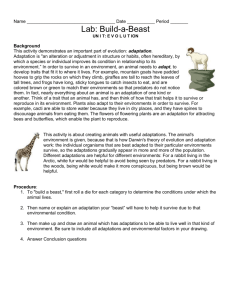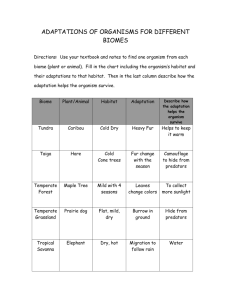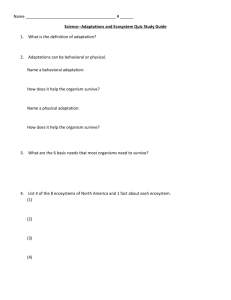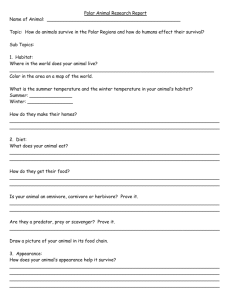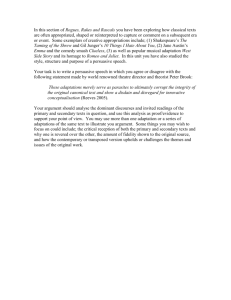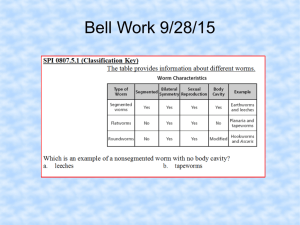Animal Adaptations
advertisement
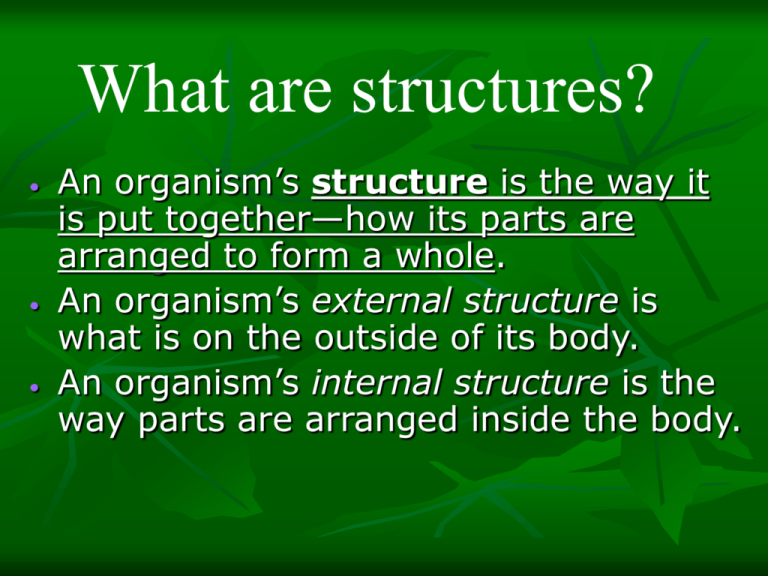
What are structures? • • • An organism’s structure is the way it is put together—how its parts are arranged to form a whole. An organism’s external structure is what is on the outside of its body. An organism’s internal structure is the way parts are arranged inside the body. What are functions? • • • An organism’s functions are the processes that allow it to survive and reproduce. Digestion is an example of a function in animals. Digestion lets animals break down foods into molecules that can be absorbed into the body. Photosynthesis is an example of a function in plants. Photosynthesis lets plants use the energy from sunlight to make food. What are adaptations? Both the external and internal structures of organisms have adaptations that enable them to perform specific functions. An adaptation is a physical characteristic or behavior that allows an organism to survive and reproduce in its environment. Reasons for adaptations To suit their habitat For protection For attacking For feeding For movement The external features of an organism determine how well the organism survives in its environment. These features can vary among individuals in a population. A.Coloration and Protective Resemblance B.Mimicry Type of External Structures Coloration and protective resemblance allow an animal to blend into its environment. Another word for this might be camouflage. Their camouflage makes it hard for enemies to single out individuals. Types of External Adaptations Mimicry allows one animal to look, sound, or act like another animal to fool predators into thinking it is poisonous or dangerous. Behavioral adaptations Behavioral adaptations include activities that help an animal survive. Behavioural adaptations can be learned or instinctive. (a behaviour an animal is born with) . An opossum plays dead. Type of Behavioral Adaptation A. Migration: This is a behavioral adaptation that involves an animal or group of animals moving from one region to another and then back again. Animals migrate for different reasons. better climate better food safe place to live safe place to raise young go back to the place they were born. Type of Behavioural Adaptation B. Nocturnal – Animals that are active during the night time hours. Usually desert animals are nocturnal to escape the heat during the day. C. Burrowing – animals that dig holes or tunnels to escape predators or extreme temperatures. •D. Hibernation is a state of greatly reduced body activity that occurs during the winter when food is scarce. Other Behavioral adaptations: • Penguins stand close together on the ice. This behavior helps them to stay warm in their cold environment. • Squirrels store bits of food in many underground locations. This behavior ensures that the animal will have enough food to survive the winter. • A spider will spin a new web to replace one that is damaged or that has worn out. Internal/Physiological Adaptations Internal Adaptations/Physiology is the way that an organism’s parts and processes function together. Variations in physiology can help some organisms survive better in their environment than others. How are gills adapted for function? • Gills are organs that remove oxygen from water. Gills have threadlike gill filaments that contain tiny, thinwalled blood vessels called capillaries. The thin structure of capillary walls is an adaptation that makes it easy for gases to move into—and out of—the fish’s blood. • When you put all the gill filaments together, they have a huge surface area. The larger the surface area, the more gas can pass into and out of the fish’s blood. How are bird bones adapted for function? • The bones of birds are filled with air spaces and therefore are almost hollow. Because this structure makes bones lightweight, it is an adaptation that helps birds fly. Struts run across the bone, making the bone strong. How are xylem and phloem an adaptation for plants? • • • Most land plants have vascular tissue, a system of tubelike structures that transport materials within a plant. There are two main types of vascular tissue—xylem and phloem. Xylem transports water from the roots upward through the plant. Phloem transports food from the leaves through the plant. The cells of xylem and phloem are long and hollow. The cells are arranged end-to-end to form tubes. This tubelike structure is an adaptation that helps xylem and phloem transport materials.



